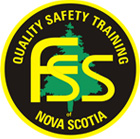Electric (Arc) Welding
Hazards Identified
Burns to skin and eyes, welding fumes, electric shock, fire
Hazard-Specific Personal Protective Equipment
Welding shield, coveralls or apron, heavy gloves, non-conductive shoes, local exhaust ventilation, respiratory protection (if needed)
Hazard-Specific Training
Welding qualification or training by a competent person
Safe Work Practice
- An eyewash station must be on site.
- If you get a direct flash to the eyes (welder’s arc eye), seek medical attention (not just first aid).
- Employees using the electric welding machines must be qualified to do so.
- Protective Equipment
- Use a number 10 or 11 filter glass to protect your eyes and wrap-around heat shield to protect your face against welding splatter.
- All filter lenses and plates should be impact-resistant and have a minimum of pitting and scratching. Cover plates should be used to protect the filter plate in hand shields or helmets.
- Helmets and hand shields should be kept in good condition and provide a light-tight mounting for the filter lens.
- Wear adequate work clothing or apron to protect the skin against heat, splatter and sunburn of the arc rays. Wear leather sleeves and spats when necessary for all-position welding.
- Wear dry, hole-free gloves, and nonconductive shoes to insulate hands and feet.
- Welding may produce fumes and gases hazardous to health. Avoid breathing these fumes and gases and wear a NIOSH approved respirator.
- All ventilation and fume extraction devices provided must be used at all times.
- Zinc (galvanized), tin, brass, cadmium, chromium and lead fumes are especially toxic to breathe and must be vented away when welding.
Electric (Arc) Welding (continued)
Before starting work:
- Know location of ON/OFF switch in case of emergency.
- Remove flammable materials from the work area.
- Make sure a fire extinguisher is readily accessible.
- Ensure that welding curtains are in place to protect other workers in the area from “flash” and welding splatter. Where this is not possible, ensure that all workers in the area are wearing tinted protective glasses or goggles and that they avoid looking at the arc.
- Ensure materials to be welded are properly secured.
Preparation of Work Area:
- When working above floor level, protect your self from a fall just in case of electric shock.
- The floor or ground should be dry in the welding area. If it is not, then stand on a wooden platform or a rubber mat. Avoid working in damp areas and keep hands and clothing dry to reduce the risk of electric shock.
- Insulate yourself from the work and ground using dry insulation. This is especially important when welding in damp locations, on metal floors, grating, or scaffolds, and particularly when in positions (such as sitting or lying) where large areas of the body can be in contact with a conductive surface.
- Keep work area as clean as possible. Do not leave used and new electrodes lying on floors, walkways, etc. so as to cause a tripping or slipping hazard.
- Keep cables out of the way, where they are not stepped on, tripped over, run over or exposed to water, grease and oil.
Preparation of Welding Machine:
- The machine must be properly grounded. Leaking current can cause shock if ungrounded parts are touched.
- Cables must be in good condition and of adequate size for the amperage they are to carry. The must not have insulation breaks and connections shall be secure and protected to prevent arcing. Repair any breaks in the cable insulation or replace cables.
- Be sure the work cable is connected to the work as close to the welding area as practical.
- Keep all equipment, safety guards, covers, and devices in position and in good repair.
Electric (Arc) Welding (continued)
Welding:
- Never change polarity switch while the unit is under load to avoid arcing of the switch contacts.
- Never simultaneously touch the electrically “hot” parts of the electrode holders connected to two welders, because voltage between the two can be the total of the open circuit voltage of both welders and voltage between the two electrode holders can be up to two times normal.
- If using the welder as a power source for mechanized welding, the above precautions also apply for the automatic electrode, electrode reel, welding head, nozzle, or semiautomatic welding gun.
- The electrode and work (ground) circuits are electrically “hot” when the welder is on. Never permit contact between “hot” electrodes or work circuits and bare skin or wet clothing.
- Never wrap the electrode cable around any part of your body since it may be pulled in some manner and cause an injury.
- Do not weld on empty containers unless you know they have been cleaned and tested.
- Shut machine off when not in use.
- Disconnect and lockout all power supplied to the welder before doing any work on the equipment.
Regulations, Standards and References
Occupational Safety General Regulations, Canadian Standard CSA W117.2-94 “Safety in Welding, Cutting and Allied Processes”,
Canadian Electrical Code, Manufacturer’s Instructions or Operator’s Manual for the electric welder being used
